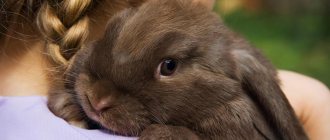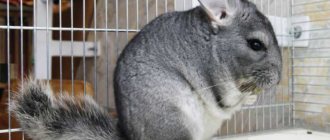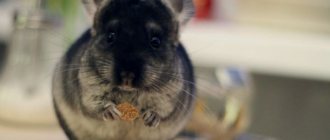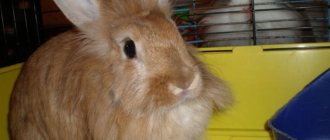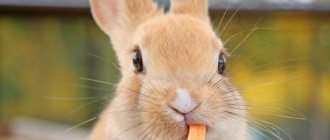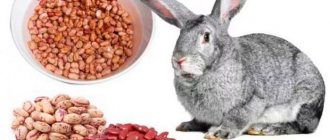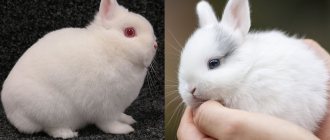Expert opinion
Dobryshev Sergey Anatolievich
Professional rabbit breeder and hare breeder with 30 years of experience
Proper care of rabbits is vital to the business called rabbit farming. This guarantees the production of a healthy, full-fledged population of animals capable of producing tasty dietary meat and beautiful fluffy fur.
The rules for caring for rabbits are not particularly complicated, but they require compliance with the necessary requirements and vigilant attention.
General signs of dwarf decorative rabbits
Decorative (dwarf) rabbits are animals weighing in the range of 1.5-2.5 kg, differing in the shape of the head and body, the length of the ears and the thickness of the coat.
Regardless of the breed, miniature animals vary in hair length.
| Type of rabbits | Hair length in cm |
| Shorthair | 1,50 – 2,0 |
| Normal hair | 2,50 – 4,0 |
| Downy (long-haired) | Over 5.0 |
Dwarf rabbits vary in fur length and ear shape
The coat of dwarf rabbits is soft and silky. The body of representatives of this class of rodents is characteristic of all rabbits - rounded, shortened in length. The head looks quite massive, its ratio with the length of the body is 1:2, the neck is practically absent. The ears of miniature rodents can be very short - up to 5-6 cm, or hang below the level of the lower jaw and reach a length of 20 cm.
Breeders are developing varieties of mini-rabbits of various colors
The purpose of dwarf rabbits is different from domestic rodents for meat or fur-and-down production. Their goal is to please their owners with their appearance, affectionate nature and playfulness. The majority of dwarf rabbit breeds are bred for keeping in a home or apartment.
Feeding
Rabbit Meal
The rabbit eats a lot. Nutritional needs depend on his weight. The main component of feed is hay. It makes up 2/3 of the diet. One adult will need about five hundred kilograms of food per year.
The summer and winter diets of rabbits are different. In summer it is more varied, fortified, and includes more juicy components.
In winter, fresh grass is replaced with straw and hay. You can diversify their diet with leftovers from your table, excluding meat and bones. To fortify the feed, pine needles are added to it.
They need mineral supplements - chalk and salt - all year round.
It is not advisable to feed rabbits with hay, grain, or solid food. They need fresh herbs, pumpkin, boiled potatoes, zucchini.
The nutrition of pregnant and lactating rabbits is supplemented with legumes, root vegetables, and mixed feed. And all fed products must be fresh, without spoilage or rot.
More information about the diet and preparation of feed for rabbits can be found here.
Why is the dwarf rabbit offended?
For any reason! I will list just a few reasons for resentment (but in fact there are many more):
* you took the rabbit for vaccination
* you put a harness on your pet and forced him to walk around in it (oh, horror!)
* you scolded a dwarf rabbit for some offense
* you trimmed the baby’s claws, washed him or, God forbid, installed a thermometer (you know where this thermometer is inserted)
* you brought another rabbit! (show this article to those who think that a dwarf rabbit needs a mate)
* you went on vacation and left the rabbit with someone else
So, what do you think of this introductory list?
It turns out that a dwarf rabbit can get offended for absolutely any reason! This does not mean that every pet will be offended by everything. Due to the characteristics and individuality of his character, he will choose what affects him. But in any case, you will experience unpleasant sensations.
The most common types of hares
The snowshoe hare acquires a spotless white coat in winter, which makes it indistinguishable in the snow. In summer, the coat takes on a grayish color. Weighs on average 3-4 kg. According to the observations of zoo workers and rehabilitation centers, it has a calmer, melancholy disposition than the brown hare and is easier to tame.
Brown hare
the largest of all hares, can weigh 6-7 kg. In summer it wears brown fur, in winter it becomes lighter, but it cannot boast of such impeccable white fur as the hare. The character is more explosive and choleric, but tolerates stress more easily than the white hare.
Tolai hare
It looks like a hare, but is small in size (weighs 2-3 kg). It is distinguished by huge ears, larger than those of a hare.
Dwarf hare
This is exactly what they often offer to buy at a pet store. In fact, there are no dwarf hares, but this name is used by one of the oldest breeds of dwarf rabbits, which are also called Polish rabbits. The Red Book Patagonian pig, a rodent that has nothing to do with the hare family, but is similar in appearance, also claims the title of dwarf hare.
Features of keeping rabbits in an apartment
The apartment must be carefully prepared for the arrival of a new resident: remove all unnecessary items from the floor, because rabbits are charming rodents and will want to taste everything they can get their hands on.
Particular attention must be paid to low-lying wires: they will have to be removed completely or hidden in cable channels. The rabbit will most likely also pay attention to wallpaper, shoes and other household items.
Rabbit cage
A place to keep a rabbit should be selected in accordance with your own preferences and capabilities. This could be a cage, house or enclosure. A cage-free option is also possible, because rabbits are very active and mobile animals.
- The cage for keeping rabbits must be selected especially carefully. It is unacceptable to use a plastic cage to keep rabbits.
- Its size should be such that the rabbit can freely stand on its hind legs and not rest against the ceiling.
- A rabbit is a burrowing animal, so it is advisable to darken the part of the cage in which the animal will rest.
- This will ensure a restful sleep and also serve as a place to hide if the rabbit needs privacy.
- A separate part of the cage should be set up as a place for eating. A feeding trough, hay barn and drinking bowl are conveniently located here. The shape of the cell is not particularly important.
- Rabbits do not like drafts, this must be taken into account when choosing a place for it.
Feeder
Particular attention must be paid to the choice of feeder. You should not buy plastic utensils, they will become unusable very quickly. It is better to give preference to a heavy ceramic feeder. This option will avoid tipping over and the food will not end up under the rabbit’s feet. The feeder and drinker can also be hung from the bars of the cage or enclosure.
Cleaning the cage
The cage requires daily attention.
It’s not difficult and won’t take much time, you just need to:
- Replace old food and hay.
- Wash the drinking bowl and fill it with clean water.
- Replace bedding or litter.
At least once a week it is necessary to carry out general cleaning in the cage: more thoroughly wash and disinfect the dishes and the room. For disinfection, you should not use solutions that contain strong chemicals; they can easily get into the rabbit’s stomach or burn its mouth.
Feeding a decorative rabbit
All food necessary for the excellent well-being of a decorative rabbit can be divided into several categories:
- concentrated - cereals, legumes, bran, mixed feed;
- coarse - twig food and hay;
- animal feed – milk, various dairy products, fish oil;
- juicy - carrots, cabbage, green salad, cucumbers;
- mineral - bone meal, salt, chalk.
It is not recommended to feed rabbits with exotic vegetables and fruits (tangerines, bananas, etc.), green potatoes, beets, and dill. Young peas and beans can cause bloating. Yeast bread, cheese, seeds and various sweets should also not be given to rabbits.
Feeding standards for each rabbit are individual. Every day, observing how much the rabbit eats, whether there is food left in the feeder or there is nothing in it for the next feeding, it is necessary to increase or decrease the portion for the pet.
Rabbit fur care
A decorative rabbit must be combed twice a week. For this, a special brush or furminator is usually used. During the molting period, the down of rabbits must be monitored especially carefully. The combing procedure should bring pleasure not only to the pet, but also to its owner.
To avoid tangles and tangles in long-haired animals, you can use various hair care products and sprays. After such procedures, the fur of a decorative rabbit becomes beautiful, smooth and shiny.
Nail care
Unfortunately, living in an apartment is unnatural for a rabbit, so from time to time it becomes necessary to cut your pet’s nails.
Of course, in this situation it is preferable to trust a specialist and take your rabbit to the veterinarian. But you can learn to perform these procedures at home.
Hand Taming
To understand how to accustom a rabbit to your hands, you need to watch it. At first he will be shy, so you need to talk to him so that he gets used to the environment and the new owner.
Rabbits at home
Since this is a burrowing animal, being raised above the ground is a shock for it. Do not lift the animal by the ears. This is very painful for him and can damage the ear membranes and muscles. This must be done very carefully so as not to cause fear:
- Stroke the animal's fur - from head to tail
- Take it under the body, supporting it from below
- Do not lift it high, keep it at the same level with you.
If you behave correctly and carefully handle the animal, then the question of how to tame a rabbit will disappear by itself.
Rabbits are animals with a developed nervous system. Loud sounds, noise, flashes of light, and unexpected changes in daily routine become stressful for him. Try to protect him from this and do not touch him when he eats, washes or sleeps.
Special toys have been created for those with big ears. Small rubber balls, soft toys, and old books will do. They develop the rabbits physically, and they don't damage household items as much. How to stop a rabbit from chewing wires: give him a toy.
Why does a rabbit bite?
The animal's aggression manifests itself in the form of grumbling, throwing and biting. They bite most often out of fear. A female with cubs may also bite to protect her offspring. Food and territory are also a matter of protection, so the reasons may vary. In order to wean a rabbit from biting you need to:
- Try to change his diet;
- Castrate;
- Treat him with care and precision to rid him of fear.
It is important for a pet to know that he and his offspring are safe, then he will stop behaving aggressively. A physiological factor such as sleep is also important.
Sometimes it seems that animals do not sleep at all. But most often they do not sleep at night, and during the day they look awake, but in fact their eyes are slightly closed and they almost do not react to sounds: this is how rabbits sleep.
Caring for a cat after castration in the first hours
After castration, a cat needs special care. Most veterinary clinics provide post-operative hospital services. In a special box with optimal climatic conditions, the operated pet is observed until it completely recovers from anesthesia. Once convinced that the cat’s condition is satisfactory, it is handed over to its owners.
Care in the first hours after castration comes down to monitoring your pets
If such a service is not available in the clinic or castration is performed at home, it is important to follow the following care recommendations:
To transport a cat after castration, it is recommended to use a loose carrier with a folding top and an absorbent diaper on the bottom. It is forbidden to transport an operated pet in your arms or in a car seat, as when waking up from anesthesia, it can harm itself or its owner. During transportation and further postoperative stay, the cat is placed on its side; It is recommended to lay an anesthetized, operated cat on the floor, since when it comes to its senses, it may fall off the table/sofa/bed. A common symptom of anesthesia sleep is uncontrollable urination. Using an absorbent diaper placed on the floor under the pet will make it much easier to eliminate such a nuisance; During anesthetized sleep, body temperature drops by 1-1.5°, so to prevent hypothermia, the operated pet is placed next to a heating radiator. It is strictly forbidden to place animals near electrical appliances with an open heating element. Instead of a battery, you can use a heating pad or a plastic bottle with hot, but not boiling water, which is placed next to the cat under a bedding or blanket
It is important that the heat does not come into contact with the cat's perineum, as this will cause bleeding. During the warm season, no additional warming procedure is required; for a more comfortable awakening from anesthesia sleep, it is recommended to close the curtains on the windows, since bright sunlight causes irritation of the optic nerve; Anesthesia sleep lasts from 15 to 120 minutes. depending on the method of administration and dose of the drug
During this time, it is necessary to monitor the cat so that it does not bury its nose in anything and suffocate. In addition, cats in this condition do not blink, which can cause the cornea to dry out. It is recommended to drip sterile saline solution, contact lens liquid, or eye drops without antibiotics into the eyes several times;
A protective collar will prevent your pet from licking the wound, further irritating it.
- Often waking up after anesthesia causes aggression in the pet. Therefore, it is recommended to provide the cat with complete rest for 24 hours, limiting access to him by other animals or children. It is forbidden to forcefully wake up your pet. Depending on the individual characteristics, after waking up, the cat may experience an unsteady gait, vomiting, involuntary urination, and a lethargic and drowsy state. This condition can last up to 8 hours, which is normal and should not cause concern;
- the wound on the scrotum after castration is not sutured, so it is recommended to minimize the amount of filler in the tray or replace it with absorbent paper. This will prevent the ingress of small filler particles and subsequent complications;
- A few hours after surgery, there may be slight bleeding from the incision, which is normal and safe for the cat. You can lightly dry the wound with a gauze cloth. In case of significant bleeding of more than 1 ml, you should urgently contact the doctor who performed the operation;
- Medicines prescribed by a veterinarian will help relieve pain. You can tell that a cat needs pain medication by dilated pupils, meowing, pursed paws, and aggression when attempting contact;
- You can prevent the possibility of damage to the healing incision by the cat’s rough tongue during hygiene by wearing a protective collar around the neck for several days. Such a product will limit the cat’s access to the wound without affecting food intake in any way.
Note! Veterinarians recommend castration in the fall or winter months, as during this period the likelihood of infection of the incision during rehabilitation is lower. In the summer, as a preventive measure for infection, the doctor prescribes a 5-day course of antibiotic treatment.
When baby rabbits leave the nest
All rabbits begin to leave the nest at three weeks of age. Getting to know the “adult” world involves some nuances:
- From this moment, acquaintance begins not only with the external habitat, but also with “adult” food - the baby rabbits try food from their mother’s feeder, which should only contain products that are harmless to babies. Gradually, the eared animals will move from such complementary foods to the normal diet of adults.
- During this period, it is necessary to change the bedding in the cage so that the miniature rabbits do not get dust into their eyes. The best option is to temporarily lay down a clean, thick cloth or towel.
- Breeders conduct a control examination of the physiological development of the offspring. If it is discovered that the rabbits are not growing well, then the rabbit’s menu is immediately revised or the baby rabbit is transferred to a female with more high-calorie milk. If there is a weakened rabbit in the brood, it is better to remove it from the nest so that the female rabbit does not begin to notice the difference among the cubs and does not abandon the entire brood because of this.
- From the 28th day, rabbits begin to be vaccinated against diseases according to the approved vaccination schedule.
Video Inspection on the 3rd day after birth
Why do baby rabbits leave the nest early?
When a mother rabbit throws her cubs out of the nest or the baby rabbits begin to emerge before three weeks of age, there may be several reasons for this behavior:
Lack of milk in the female. A decrease in the amount of rabbit milk or a decrease in its nutritional properties indicates that the rabbit is not eating properly. To restore normal lactation, you should review the eared mother’s diet, make it more nutritious, and adjust the diet and volume of food. Taking good care of your rabbit is the key to getting healthy offspring from her. If lactation cannot be restored, then the offspring are placed with another lactating rabbit or artificially fed.
Increase in air temperature in the queen cell. In order for the baby rabbits to feel comfortable and cozy, the temperature in the nest should be controlled. When it becomes very hot and stuffy, the problem can be eliminated by moving the cage to a cooler room or to the open air under a canopy.
It is important to remember that the rabbits should not emerge from the queen cell before the due date. If this problem occurs, you should quickly find and eliminate the cause, otherwise you may lose the brood
When can weaning take place?
It is recommended that older rabbits be separated from their mother no earlier than 1.5 - 2 months of age, provided that they already eat full adult food, do without milk, and do not get sick. The weaning procedure is carried out gradually, removing 2 rabbits from the litter daily. In this way, the female will physiologically and painlessly stop lactation.
Typically, females are placed in cages of 3-4 individuals, and males are castrated or transferred to individual cages (provided they are kept for breeding).
After weaning, the most important aspect is the diet of the young animals. They should receive a high-calorie diet rich in proteins and carbohydrates. It is recommended to enrich the food composition with mineral and vitamin premixes. If 3-4-month-old young animals gain weight well and quickly, then the transition to adult food has taken place well, and the selected nutrition meets all the nutritional needs of actively growing organisms.
Video NEWBORN BABIES
Is it possible to grab it by the withers?
If you look at the photo below, you will see that it is also not recommended to take an animal by a fold of skin on the neck or back. This is not as dangerous as in the case of the ears, but there are other, safer ways.
The fact that this method is more comfortable for the animal is evidenced by the fact that, as a rule, in this situation it does not break out or scratch. Most often, the crawl simply hangs down, while its neck and head are pulled back somewhat.
If you use this method of lifting, then you must support the crawl’s body in the sacrum area with your second hand.
By the way, it is by the withers that the rabbits are carried by their parents. Some rabbit breeders advise holding animals with both hands at the same time: one in the neck area, the other in the back area. This way it will be in a horizontal position, and the body weight will be evenly distributed.
Preparation for construction
To prevent animals from getting sick, you should first of all properly arrange the rabbitry. However, before you start arranging the premises, you should decide on the method of keeping living creatures.
Content options
There are 2 popular ways of keeping animals: free and caged. Preference should be given to the cellular method of maintenance, which has several advantages over the free method.
- For rabbits, diet is extremely important. Consumption of some herbs that grow everywhere can cause serious health problems. Cellular content eliminates independent search for food, and, accordingly, the risk of poisoning.
- When kept in cages, up to 20 animals can be accommodated in a small area.
- Breeding rabbits occurs according to a predetermined plan. When kept freely, it is impossible to keep track of mating.
- Allows you to select suitable individuals for mating. When kept freely, mating occurs spontaneously, and offspring will be produced not only by strong, but also by weak individuals.
- Cage keeping allows for timely identification of a sick individual and isolation of it from the rest.
- Cages are easier to care for than an aviary.
To eliminate the spread of infections and increase the comfort of life for your pets, you need to carry out regular cleaning
There is also pit or pit free housing. Its peculiarity is that the rabbits are in a hole dug in the ground. However, it is difficult to care for the livestock, monitor the mating of males and females, and provide the correct diet for each animal in such conditions.
Selecting a location
If kept freely, it is necessary to prepare the enclosure by fencing it with a chain-link mesh or other material that acts as a fence. On the territory of the enclosure it is necessary to install a rabbitry in which the animals can hide from bad weather and spend the night. Floor maintenance involves insulating the floor. You can give each rabbit a cage.
Cages are installed in open space or indoors. A garage or shed will do. A small number of rabbits can be kept even on the balcony of an ordinary apartment. However, even if sanitary and hygienic standards are observed, the place of detention has a specific smell that will be heard in the apartment, which is a significant drawback of apartment housing.
Keeping them outdoors involves choosing a place to install cages. Rabbits are afraid of drafts. It is better to prepare a place for installing cages near other rooms that will protect them from the wind.
Animals should not be exposed to direct sunlight. Although a too shaded place is also not the best option
It is important to find a middle ground here
You should not install pet houses in the lowest areas, where the air humidity level is often high. A hill is also not suitable - it is the windiest place.
Difference from sterilization
Castration of rabbits is an operation as a result of which they are deprived of the opportunity to have offspring. Spaying rabbits is sometimes called neutering, but there is a significant difference between the two. Since sterilization does not involve resection of any organs, the ability to reproduce disappears, but the natural desire to mate remains.
Sterilization of rabbits involves bandaging. In this case, the reproductive organs are ligated - in females the fallopian tubes, and in males the seminal ducts. The behavior of animals during certain periods remains aggressive and unpleasant.
Unlike sterilization, castration of rabbits immediately solves all problems that have arisen. The result of castration of rabbits is the absence of pregnancy. Their behavior also changes - they stop falling into a state of hunting, that is, the natural desire to mate disappears. Even during the mating season, their behavior continues to remain calm.
The essence of castration of rabbits is to cut off the ovaries in females and the testicles in males. You can have your rabbit castrated by professionals or by yourself.
Lifespan and sex determination
On average, furry rodents live from 5 to 10 years. It all depends on the care and maintenance, on the attitude towards the animal. Large females become sexually mature at 5-8 months, and decorative ones at 4-6 months. The reproductive instinct is pronounced, pregnancy lasts about a month. In the litter of large breeds there is a maximum of 12 cubs, in decorative breeds - up to 5 individuals.
Giant White Rabbit Family
After giving birth, small and helpless rabbits are born. Newborn babies are born naked, their eyes open after 2 weeks. They begin to eat independently 15-17 days after birth. In the first days of life and during the growth period of the rabbits, the female rabbit needs to be fed well, and try to make her diet more varied. Baby rabbits need to be cared for with care and caution. Babies must be with their mother for up to 3 months, after which they are prepared for sale. So the female takes care of the rabbits for up to 3 months.
The sex of baby rabbits can be determined closer to 3 months of their life.
Until the age of three months, no one will answer the question of how to find out the gender of a rabbit, since during this period it is impossible to find out the gender. In older animals, males can be distinguished from females only by their reproductive organs. The sex of a rabbit is determined by carefully examining the reproductive systems of the rabbit and the female rabbit. This is the only method by which one can tell whether a boy or a girl has been born.
How to determine the age of a rabbit?
It is impossible to determine exactly how many years animals live by external signs. But there are a number of techniques that allow you to do this:
- Palpation of the ribs, which can be easily felt. Up to 6 months, the ribs are soft;
- Teeth enamel color. The yellower the teeth, the older the rabbit;
- In an adult “eared” eyelids sag, swell, and become uneven;
- The length of the claws, even if they are cut, these places are clearly visible. In older individuals they bend.
Experienced rabbit breeders can determine the approximate age of an animal based on these characteristics. It is impossible to do this by size, since the size depends on the breed and a number of other factors.
Accommodation features: rabbit house
If you decide to get rabbits and create a mini-farm in the village, then at the first stage you need to take care of their place of residence. A ready-made room for a rabbitry is created or used. The animals will be housed more compactly in 2-tier cages. Keeping rabbits indoors is more convenient and rational. Drafts and dampness, prolonged exposure to the sun should be avoided, but ventilation should be provided.
Outdoor home cage option
For a pet, the cage is placed away from heating appliances. If you raise a rabbit in a hot room, the rabbit will experience constant thirst and its health will worsen. It is not recommended to keep him in a cage all the time. In order for the indoor pet to feel good, it is allowed to run around the apartment.
Longer stay for pets - their cage
Keeping an animal’s “house” clean is an important condition for its health. Dirt and urine cause diseases of the respiratory system and eyes, so the tray is cleaned three times a week
Once a week, wash thoroughly using disinfectants.
Portable cage option
Feeders, drinking bowls, and hay mangers should be placed in the cage. They need to be well secured so that the animals cannot spill water or contaminate the food. They need to be washed as often as possible.
Animals love to eat indoor flowers. It is necessary to remove poisonous plants from the apartment, install the rest on cabinets or hang them in flower pots.
Is it possible to keep rodents together with chickens? Their cohabitation is possible only if there are no other options. Although they are completely different species, they have common diseases. In addition, the “eared” ones feel uncomfortable in the company of noisy and hectic hens. Therefore, keeping chickens and rabbits together is not recommended.
FAQ
Those who plan to adopt and care for a long-eared animal should know everything about rabbits. Below are questions that interest beginning rabbit breeders:
- What is the lifespan of an animal? On average, decorative rabbits live 9-12 years, but much depends on the conditions of detention and the quality of care.
- Why did the animal begin to show aggression? Some individuals change their character after puberty. Castration will help solve the problem.
- Is it worth raising rabbits at home? This is not an easy task - keeping an entire family of rodents involves large financial and time costs. In addition, female rabbits often abandon their offspring, then caring for the cubs falls entirely on the shoulders of the owner.
- Is it true that rabbits eat their own droppings? Yes, but they only eat caecotrophs - morning soft feces, which contain many useful substances. This phenomenon is called coprophagy.
- Why do rabbits eat all the time? In these animals, digestion is designed in such a way that food moves through the intestines due to the arrival of a new portion. Therefore, it is important that your pet always has access to food and water.
There are many nuances in keeping and caring for decorative rabbits that you should learn about in advance. The health and well-being of your pet depends on this.
